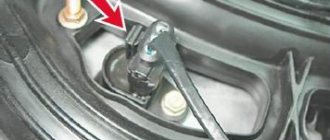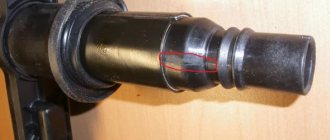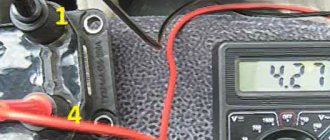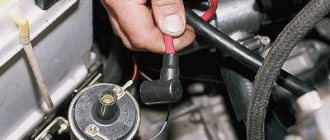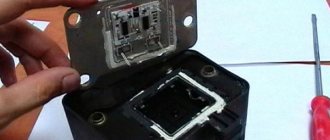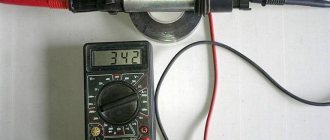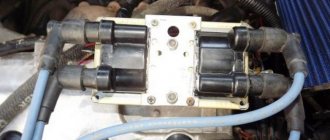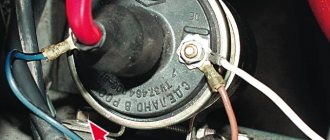This part is one of the main ignition systems for gasoline engines. Great importance is attached to the coil because the air-fuel mixture, compressed by high pressure, can only be ignited by a spark from a spark plug. To break through the spark gap, a high voltage must be applied. Its value is more than 30 thousand volts. This voltage is generated by the ignition coil.
As the design of the car improved, changes occurred in vehicle ignition systems. Several types of coils have been developed and are successfully used to produce high-voltage voltage, but they cannot be called interchangeable.
The photo shows a reel of Moskvich cars. A special feature of the product is the presence of an additional resistance connected in parallel to the primary winding. Used in contact ignition systems.
Increasing the power of the power unit required increasing the engine compression ratio, and this entails an increase in high voltage. Therefore, the spark generation system, including the coil, has changed. Further modernization of the product led to the appearance of products with four terminals of high-voltage wires, double, individual samples.
The appearance of the device of the VAZ 2108 family of cars shows the difference from the previous design.
Design
The failure of this extremely valuable element of the on-board electrical circuit does not bode well. The car becomes motionless because the engine does not start, the stove does not provide heat, and the lights do not work. A complete, high-quality repair of the ignition coil and tip is required. To do it yourself, you need to study the structure of this unit.
The coil consists of the following components:
- insulator;
- frame;
- insulating paper;
- primary winding;
- secondary winding;
- insulating layer between windings;
- output contact of the primary winding;
- contact screw;
- central contact;
- lid;
- output contact of the primary and secondary windings;
- center contact spring;
- core of the secondary winding;
- outer insulating layer of the primary winding;
- bracket for attaching the coil;
- external magnetic circuit;
- core.
This part is a transformer with a metal core. The primary winding is located on top of it, and the secondary winding is located below it. The steel body is hermetically sealed. Oil is poured inside along with the core.
To make it possible to service the transformer, there is a plastic cover. It successfully withstands high voltage. The coil is installed in a contactless electronic ignition system with low-voltage and high-voltage circuits.
A few words about the BZS (Contactless ignition system) VAZ 2106
The coil operating as part of a contactless circuit differs in the number of turns of the primary and secondary windings. Simply put, it is more powerful than the old version, since it is designed to create pulses of 22-24 thousand volts. The predecessor supplied a maximum of 18 kV to the spark plug electrodes.
The cable with connectors is used for reliable connection of the terminals of the ignition distributor and the switch. The structure of these two elements should be considered separately.
In terms of reliability, the BSZ is significantly superior to the outdated contact ignition of the “six”; problems arise much less frequently and are easier to diagnose.
All elements of the system are connected to each other and to the engine as follows:
- The distributor shaft rotates from the motor drive gear;
- The Hall sensor installed inside the distributor is connected to the switch;
- the coil is connected by a low voltage line to the controller, a high voltage line to the central electrode of the distributor cover;
- high-voltage wires from the spark plugs are connected to the side contacts of the main distributor cap.
The threaded clamp “K” on the coil is connected to the positive contact of the ignition switch relay and terminal “4” of the switch. The second clamp marked “K” is connected to contact “1” of the controller, and the tachometer wire also comes here. Terminals “3”, “5” and “6” of the switch are used to connect a Hall sensor.
One of the effective options is to replace the standard ignition system with a non-contact ignition system (abbreviated as BSZ), where electronics are in charge of sparking
Job
Ignition coils convert low voltage currents into high voltage currents. Then they are fed to the spark plugs, where as a result of the impulse a spark appears between the electrodes and the engine starts. All 12 V products from global manufacturers have a similar structure, differing in the number of turns, the cross-section of the wire of the primary and secondary windings, and the connections between them.
The coil operates in contact with a distributor-breaker, or distributor. When the distributor is operating, the amount of current in the primary winding on the coil is constantly changing. The current becomes less when the contacts open and more when they close. The amount of current in the primary winding depends on the closing time of the distributor contacts.
When the engine operates at high crankshaft speed, the contacts close for a short time. The current in the primary winding and the voltage in the secondary winding become smaller. Such conditions for a multi-cylinder engine lead to interruptions. To reduce the negative effect, a resistor or variator is soldered in series to the primary winding.
The resistance value in the primary winding becomes variable. It is greater at low engine speeds and decreases as it increases. The magnitude of the current increases. When the starter, which consumes a large amount of current, starts the engine, the voltage at the battery poles decreases. A similar process occurs in the primary winding.
Repair
Finding a new ignition coil today is not particularly difficult. In order to repair a broken bobbin, it is not at all necessary to buy the entire reel. Auto parts stores sell quite a lot of repair kits, among which you can easily choose an option for your car.
Note. When selecting a bobbin repair kit, you should pay attention to the number of motor valves.
On the other hand, in remote areas of the Russian Federation, sellers are in no hurry to sell spare parts in the form of repair kits, preferring to sell assembled reels, which is beneficial for them in all respects.
One repair kit costs no more than 150 rubles. This also includes the spark plug well insulator and seal. If the car engine is 4-cylinder, then you need to take 4 repair kits at once.
Definition of failure
If the ignition coil is faulty, the car either does not start, or the running engine stalls, stalls, and brings a lot of inconvenience.
Checking the part: turn off the ignition, disconnect the battery terminals, remove all wires from the coil. An ohmmeter measures the resistance value between terminals 1 and 4, 2 and 3. If the resistance on these pairs is not 5–6 ohms, the part being tested is faulty.
If you don't have an ohmmeter, you need to remove the coil from a known-good car. If after this the car starts with a quarter turn, therefore, there is a breakdown of this part, it must be replaced. Another way to determine a non-working coil and a high-voltage wire tip. With the engine running, remove the wires from the spark plugs one by one and short them to ground.
If there is no spark on one of the wires, or it is significantly smaller than the others, there is a problem with the coil or high-voltage wire. You need to try with a different, working cable. It turned out well, the cable is to blame. If the same thing happens, the ignition coil needs to be replaced.
Checking the bobbin
Before starting to repair the bobbin, it is recommended to properly check the part. Diagnosis is easy to do on your own.
There are three test methods:
- The connectors are disconnected from the reel one by one at the moment when the power unit begins to trip. If, when the connector is disconnected, the dips in speed do not increase, it means the element is faulty.
- The bobbin is removed. The degree of current resistance on the windings is measured. The voltage is measured directly between mutual contacts, as well as between the connector and contacts. The current level must be 6-8 kOhm on the first and 0.4-2 Ohm on the secondary windings.
- You can verify that the reel is faulty using the error code issued by the on-board computer.
Cleaning
After washing the engine, driving in heavy rain, after winter parking, ignition breakdowns appear and the engine tunes up. Motorists have to carry out preventive cleaning of the ignition coil, tip, and conductive cables with their own hands.
- You need to stock up on alcohol, a small file, and cotton swabs.
- The rubber insulator boot is carefully bent off the tip of the ignition coil.
- The springs and radio interference suppression resistor are removed.
- Springs and resistor tips must be aligned with the crimping force. If this is not the case, they bend slightly.
- Everything is cleaned of dust, dirt, oil, rust, and wiped with alcohol.
- The tip springs need to be slightly stretched.
Results
After cleaning the ignition coil and tip with your own hands, the engine will please the car owner with proper operation. In general, this procedure will not cause much difficulty, and cleaning it yourself will help save money on repairs.
The ignition coil is one of the main elements in the control system of gasoline engines. Its failure leads to a lack of ignition in one or more cylinders. Therefore, every car owner should know the main signs of an ignition coil malfunction and the symptoms that precede the occurrence of this situation.
Do-it-yourself repair of the VAZ 2110 ignition module, how to check and replace
The motor control system includes a wide range of different elements, each of which plays its own important role.
In some situations, high voltage disappears on several or even one cylinder. The reason for this may be the ignition module on the VAZ 2110, or rather its malfunction.
It should be noted that replacing the ignition module of the VAZ 2110 may not be necessary. First try to repair it, diagnose and fix the problem.
Purpose, principle of operation of the ignition coil
The device is the most conservative part in a gasoline internal combustion engine. Its prototype was invented in Germany by the engineer Ruhmkorff in the mid-nineteenth century. It replaced magnetos in automobile engines in the early 20th century.
The main purpose of the device is to convert low-voltage electrical pulses with an amplitude of about 12 Volts (vehicle on-board voltage) into high-voltage pulses with an amplitude of more than 15,000 Volts. High voltage is necessary to break down the working area of the spark plug.
According to the type of design and ignition circuit, the coils are classified:
- single;
- double (triple, four-block);
- individual.
Ignition coil design
Single devices are used in systems with an ignition distributor. Twins are used in four-cylinder internal combustion engines without a distributor. One part forms a high-voltage pulse to the 1st and 4th cylinders, the second serves the 2nd and 3rd. Triple and quad coils are sometimes used in six-cylinder and eight-cylinder engines, respectively. Individual coils are widely used in modern cars. They are installed on each spark plug individually. A custom spark plug coil has a number of advantages over conventional ones:
- failure of one of the devices does not lead to a complete stop of the engine;
- it is easier to organize an electronic control scheme;
- the absence of a mechanical ignition distributor makes the system more reliable;
- distribution of pulse load reduces currents and increases service life;
- it is easier to identify a faulty device, which is easily done by computer diagnostics;
- Most individual coils have a pulse amplifier installed; it is controlled by low signal currents, which reduces electrical interference and increases the reliability of electrical equipment.
By type of control they are divided into:
- contact;
- electronic;
- with built-in switch (pulse amplifier).
In the ignition contact bobbins, a low-voltage pulse is generated by a chopper. When the primary circuit is switched by a breaker, an electromotive force pulse is induced in the primary circuit. The device is an autotransformer that increases the pulse amplitude N times, where N is the transformation coefficient equal to the ratio of the number of turns in the secondary to the primary winding. The transformation ratio of contact devices exceeds 1000.
Contactless systems use electronic coils. Their transformation ratio is higher and they form a stable spark. During repairs, contact and non-contact devices cannot be interchanged.
A built-in switch is installed on most individual coils, often installed on dual coils. Their disadvantage is a higher probability of failure due to the presence of electronic components.
About the repair of such parts.
Old models suffer from a problem when the additional resistance burns out. Such “grief” can be corrected with our own hands. To repair it, it must be dismantled; before doing this, you should remember the location of the suitable wires. The burnt-out additional resistor is rewound. A St0 steel wire with a diameter of 0.4 mm and a length of approximately 140 cm is used.
It should be wound on a core with a diameter of 0.5 mm. The finished spiral is riveted to the contact plates, placed in the groove of the ceramic plate, and filled with liquid glass or epoxy resin. A current flows through it, heating the spiral, so it is filled with compound. The winding resistance is checked with a multimeter; it should have a value of 1.25 - 1.4 Ohms.
You can use nickeline wire of the NP 2 brand. The diameter is chosen to be approximately 0.3 mm, winding is carried out on a mandrel with a diameter of 3.5 - 4 mm. This is done with your own hands, using a device for winding coils, a drill or other devices.
The picture shows the tattered resistance of the Moskvich 412.
More modern products do not have additional resistance, but they are plagued by other types of faults that are easy to detect by external inspection. These include mechanical damage to the case, chips of the carbolite cover, wear of the threads on the contact screws, breakdown of the high-voltage pulse to ground.
A faulty cover that is pierced is replaced with a new product. You need to carefully flare the edges of the metal case, remove the defective part, and install a new cover. After this, wrap the edges of the body again. Usually performance can be restored.
Important! The coil is cooled by transformer oil, so be careful not to spill it. If this suddenly happens, you need to add the required amount of liquid.
Some drivers try to repair cracks or chips in the cover with epoxy resin. To do this, they make “ingenious formwork”, which is filled with a mixture of epoxy resin and filler. In some cases, DIY repairs are possible, but in most cases this does not last long.
Symptoms of malfunction
More often than not, the bobbin does not suddenly fail. This is usually preceded by a number of warning symptoms.
The main symptoms of a faulty ignition coil:
- misfires in one or more cylinders, they can be determined using a scanner by the presence of the “triple” effect of the engine;
- the appearance of “breakdown tracks” on the housing can be determined visually when starting the engine in the dark;
- the occurrence of cracks and chips in the dielectric zone;
- overheating of the structure;
- burning of rubber tips of high-voltage wires;
- oiling, contamination.
If the above symptoms appear, you should consider purchasing a replacement device. You can't stand by and watch an ignition coil die. In the event of a sudden coil failure, further independent movement will be impossible (unless you have individual coils installed).
Ignition coils
Ignition module
As mentioned above, the “ten” has 4 engine types: 16 and 8 valve internal combustion engines, as well as with a volume of 1.5 and 1.6 liters. This will lead to differences in the ignition modules. Depending on the installed engine with a certain volume, its own ignition module will be installed.
Differences
The main differences between the modules will be the size and mounting holes. In a 1.5 liter internal combustion engine, the ignition module is larger in size in contrast to the 1.6 liter engine. The cost of the modules depends on the manufacturers, but it should be noted that the MZ from a 1.5 liter engine is always more expensive than a 1.6 liter one.
16 valve MZ
In a 16-valve internal combustion engine, the ignition module is installed on the valve cover near the oil filler neck.
8 valve MZ
The MZ on an 8-valve engine is installed on the front of the cylinder block between the dipstick and the breather.
Symptoms of a problem
The main signs of ignition coil failure are lack of ignition. If it is a single device with a distributor, then in all cylinders; if it is a double or single device, then in those served by it. The absence of a spark is not necessarily a 100% sign of a faulty coil. Perhaps the limiting resistor has burned out, the spark plug is faulty, the high-voltage wire has broken, or there is a malfunction in the ignition system. A comprehensive fault diagnosis is required.
Visual signs that the ignition coil is not working:
- the presence of “breakdown tracks”, oxides on the coil;
- change in dielectric color;
- burning of contacts and connectors;
- traces of overheating on the body;
- increased pollution.
How to fix a breakdown
As for the question of how to fix a breakdown, there are two options - fast (“field”) and slow (“garage”). In the latter case, everything is simple - it is advisable to completely change the coil, especially if the breakdown is significant. As for quick repairs, either electrical tape or glue is used for this.
Isolating a damaged coil
The most interesting question for car owners in this context is how to eliminate a breakdown of the injection ignition coil? In the simplest case, that is, if there is a small spark breakdown on the body (and this is the most common type of breakdown), after localizing this place you need to use insulating materials (insulating tape, heat shrink, sealant, epoxy glue or similar means, in some In cases, even nail polish is used, but the polish should only be colorless, without any paints or additives), and isolate the place (path) of the breakdown. It is impossible to give universal advice; it all depends on the specific situation.
When performing repairs, it is necessary to clean and degrease the area of electrical breakdown before applying a protective insulating layer to it. This will increase the resistance value of the resulting insulation. If, when the insulation is damaged and there is a breakdown, liquid appears in the coil (usually from a damaged seal), then it makes sense to additionally use dielectric grease.
Well, in the most severe case, you can, of course, install a new coil. It can be original or not - it depends on the price. Many car owners are saved by the so-called “dismantling shops”, that is, places where you can buy spare parts from disassembled cars. They are cheaper there and you can easily find high-quality components.
How to identify a faulty ignition coil
The procedure for checking the serviceability of the coil depends on how many ignition coils are in the car. If your car has individual ignition coils, in order to identify the faulty one with a high degree of probability, you can swap the supposedly faulty and known-good coils. If, as a result of this replacement, a spark appears in the cylinder in which there was no spark, and disappears in the other, therefore, the bobbin is truly faulty. In the same way, you can check dual and block coils, but you will have to modify the circuit, which is not always convenient.
How to determine which ignition coil is not working without making changes to the electrical circuit
To do this, you need to stock up on thick dielectric gloves and a dry rubber mat. The use of only ordinary dielectric gloves is unacceptable: they can withstand a breakdown voltage of 6300 Volts; the voltage applied to the candle is approximately three times higher.
If your car has two or more ignition coils, if one of them malfunctions, the car should start, but struggle a lot. By removing the tips of the high-voltage wires of the spark plugs or connectors from individual coils one by one, the stability of the engine is assessed. If the internal combustion engine has not changed its operation as a result of removing the connector, then there is no spark in this cylinder. If the engine starts to shake even more, or stalls altogether, there is a spark, the bobbin is faulty, or it is not receiving impulses or power.
A little about prices
We have already noted which switch and transistor are used when repairing the ignition module of a dozen. The first costs about 3 dollars, and for the second you will have to pay about 6 dollars.
Some craftsmen use a domestic analogue of the transistor - model KT848A . Of course, it costs less. But its problem is its lower quality and larger size, which somewhat complicates the repair process.
Source
